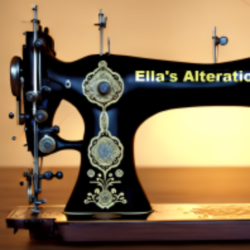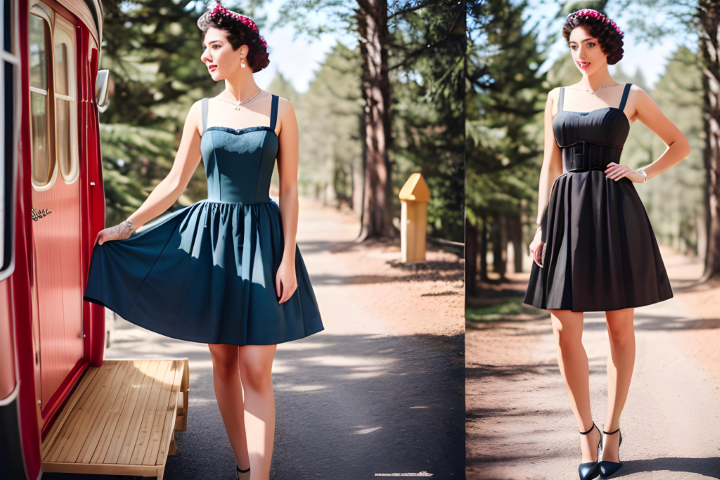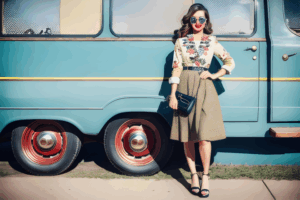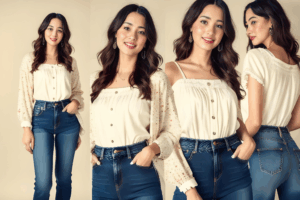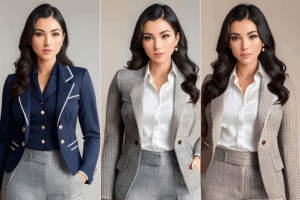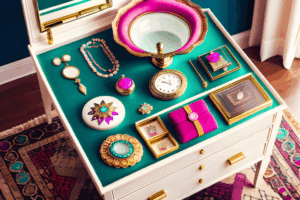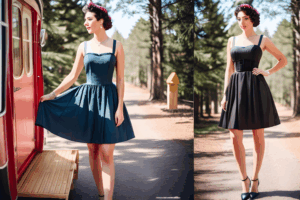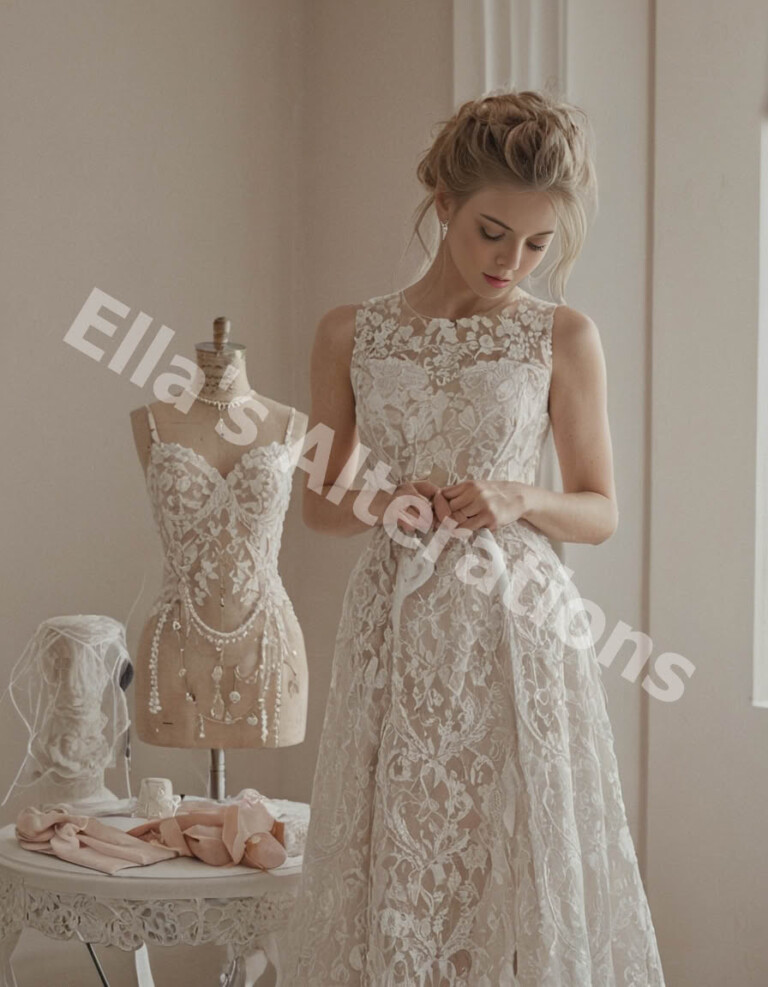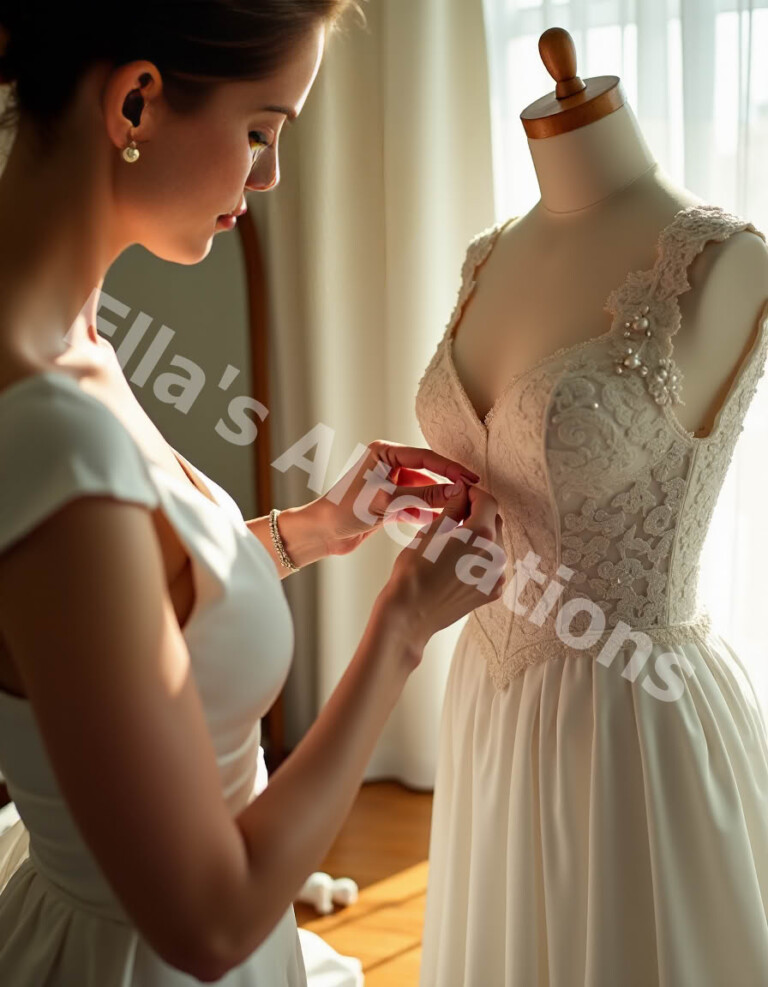Vintage Revival Alterations: A Nostalgic Journey for…
Vintage Revival Alterations: A Nostalgic Journey for Fashion Enthusiasts |
IntroductionVintage Revival Alterations: A Nostalgic Journey for Fashion Enthusiasts. In today's fast-paced world of ever-changing fashion trends, there is a timeless allure to vintage clothing that captures the hearts of nostalgic fashion lovers. The charm of bygone eras and the unique craftsmanship of yesteryears hold an irresistible fascination for those seeking to infuse their wardrobe with a touch of history and individuality. Vintage revival alterations offer a remarkable opportunity to breathe new life into classic garments, blending the old with the new and allowing personal expression to shine through. In this blog, we will delve into the world of vintage revival alterations, exploring the techniques, inspiration, and benefits for fashion enthusiasts seeking to honor the past while embracing the present. |
|
|
Understanding Vintage FashionTo embark on a journey of vintage revival alterations, it is essential to develop an understanding of vintage fashion. This section will delve into the different eras of fashion and highlight the defining characteristics and signature styles of each period. From the flapper dresses of the Roaring Twenties to the vibrant prints of the swinging Sixties, we will explore the rich tapestry of fashion history and the key elements that make vintage clothing truly distinctive. The Roaring Twenties: The Age of Glamour and FlappersThe 1920s, also known as the Roaring Twenties or the Jazz Age, was a time of significant social and cultural change. Fashion reflected this newfound liberation, with women embracing shorter hemlines, dropped waistlines, and a relaxed silhouette. The iconic flapper dress, characterized by its loose fit, fringed embellishments, and art deco influences, became a symbol of the era. Feathered headbands, T-strap shoes, and long pearl necklaces were popular accessories that completed the glamorous flapper look. The Elegant Thirties: Hollywood Glamour and Bias-Cut GownsThe 1930s witnessed the rise of Hollywood glamour and the influence of the silver screen on fashion. Bias-cut gowns, which clung sensuously to the body, were a hallmark of this era. Women embraced feminine silhouettes, with figure-hugging dresses, puffed sleeves, and high waistlines. Luxurious fabrics such as silk and satin were commonly used, and accessories like gloves, cloche hats, and statement brooches added a touch of elegance to outfits. The War Era Forties: Utility and Feminine AdaptationThe 1940s were dominated by World War II, which had a significant impact on fashion. The focus shifted to utility and practicality, with rationing leading to simpler designs and the use of less fabric. Women adapted by making do and mending, creating innovative styles from limited resources. Despite the challenges, fashion remained feminine, with A-line skirts, tailored suits, and sweetheart necklines. Platform shoes, berets, and victory rolls in hairstyles were popular elements of the era. 1.4 The Fabulous Fifties: Hourglass Silhouettes and Nipped WaistsThe 1950s saw a return to glamour and femininity after the war. The hourglass silhouette became synonymous with the decade, with cinched waists, full skirts, and emphasized busts. The New Look, introduced by Christian Dior, revolutionized fashion with its voluminous skirts and tailored jackets. Pastel colors, polka dots, and floral prints were prevalent, and accessories like cat-eye sunglasses, pillbox hats, and pearl jewelry completed the elegant ensembles. The Swinging Sixties: Youthful Rebellion and Mod FashionThe 1960s brought about a cultural revolution and a break from traditional norms. The mod fashion movement emerged, embracing bold colors, geometric patterns, and futuristic designs. Mini skirts, shift dresses, and go-go boots epitomized the youthful and energetic spirit of the era. The Beatles' influence on fashion cannot be overlooked, with their collarless suits and shaggy haircuts inspiring a generation. Statement accessories like oversized sunglasses and chunky jewelry added a touch of rebellion. The Eclectic Seventies: Bohemian Vibes and Disco FeverThe 1970s embraced a mix of styles, ranging from the bohemian hippie culture to disco glamour. Flowing maxi dresses, bell-bottom pants, and peasant blouses captured the free-spirited essence of the era. Platform shoes, fringed vests, and floppy hats were popular accessories. As the disco era took hold, glittery fabrics, jumpsuits, and wide lapels became the go-to fashion choices for those looking to dance the night away. The Retro Eighties: Bold Colors and Power DressingThe 1980s marked a bold and eclectic era with a focus on excess and self-expression. Power dressing was prominent, with sharp shoulder pads, tailored suits, and bold colors exuding confidence. Neon hues, animal prints, and statement accessories dominated the fashion scene. Leg warmers, chunky jewelry, and big hair were hallmarks of the era, as individuals embraced their individuality through flamboyant fashion choices. By understanding the defining characteristics of each fashion era, vintage fashion enthusiasts can gain insights into the elements that make each period unique. This knowledge serves as a foundation for creating authentic vintage revival alterations that capture the essence and spirit of the chosen era. It allows fashion lovers to embrace the nostalgia and charm of the past while infusing their personal style into their wardrobe. |
| Ella's Alterations LLC 813-445-8894 https://ellasalterations.com |
The Appeal of Vintage Revival AlterationsWhy do fashion lovers find vintage revival alterations so appealing? This section will explore the various reasons behind the growing fascination with vintage clothing and the desire to breathe new life into classic garments. From the quality of construction and attention to detail to the nostalgia factor and the sustainability aspect, we will delve into the unique appeal of vintage revival alterations and why they hold a special place in the hearts of fashion enthusiasts. Quality Craftsmanship and Timeless AppealOne of the primary reasons vintage clothing captivates fashion lovers is the superior craftsmanship and attention to detail found in garments from the past. Vintage pieces were often made with high-quality fabrics and constructed with precision, resulting in durability and longevity. The use of techniques such as hand-sewing, intricate embroidery, and delicate embellishments adds an air of luxury and uniqueness to vintage garments. By engaging in vintage revival alterations, fashion enthusiasts can celebrate and preserve these exquisite details, giving new life to garments that would otherwise be forgotten. Nostalgia and Personal ConnectionVintage fashion has the power to evoke nostalgia and create a sense of connection to the past. Wearing vintage garments or modified vintage pieces allows individuals to embrace the styles of previous decades and pay homage to the fashion icons of yesteryears. Vintage revival alterations enable fashion enthusiasts to infuse their own personal touch into these nostalgic pieces, creating a unique blend of past and present that reflects their individuality. Whether it's recreating a favorite style from a beloved movie or channeling the elegance of a bygone era, vintage revival alterations provide a way to manifest personal connections and evoke fond memories through fashion. Unique and Individual StyleIn a world of fast fashion and mass production, vintage revival alterations offer a chance for individuals to stand out and express their personal style in a distinctive way. By transforming vintage garments through alterations, fashion lovers can create one-of-a-kind pieces that reflect their unique taste and preferences. Vintage fashion allows for experimentation and self-expression, providing a canvas for creativity and originality. The ability to customize vintage pieces ensures that the resulting outfits are truly individual and reflective of the wearer's personality. Environmental and Sustainable FashionThe growing interest in sustainable fashion has contributed to the appeal of vintage revival alterations. By reusing and repurposing existing garments, fashion enthusiasts actively participate in reducing waste and minimizing the environmental impact of the fashion industry. Vintage revival alterations align with the principles of sustainability by extending the lifespan of clothing and reducing the need for new production. This approach promotes a circular fashion economy and encourages responsible consumption. Ethical ConsiderationsIn addition to environmental sustainability, vintage revival alterations also address ethical concerns in the fashion industry. The production of new clothing often involves exploitative labor practices and unsafe working conditions. By choosing to modify vintage garments, fashion lovers can opt for a more ethical alternative that supports fair trade and respects the rights of workers. Vintage clothing already exists, eliminating the need to contribute to the demand for new clothing that may be produced under unethical conditions. Unique Investment PiecesVintage revival alterations provide an opportunity to invest in unique and valuable pieces. Certain vintage garments, especially those from iconic fashion houses or renowned designers, can appreciate in value over time. By altering and revitalizing these vintage treasures, fashion enthusiasts can enhance their worth and create highly sought-after fashion items. Vintage revival alterations thus offer not only personal satisfaction but also the potential for future financial gains. The appeal of vintage revival alterations lies in the superior craftsmanship, nostalgic connection, personal style expression, sustainability, and ethical considerations associated with vintage fashion. By embarking on this journey, fashion enthusiasts can unlock the potential of classic garments, transforming them into cherished pieces that seamlessly blend the old and the new. Vintage revival alterations offer a unique and meaningful way to engage with fashion history, create individualistic outfits, and contribute to a more sustainable and conscious fashion industry. |
| 5 Body Types For Wedding and Alterations |
|
Ella's Alterations LLC 813-445-8894 https://ellasalterations.com |
Sourcing Vintage GarmentsFinding the perfect vintage piece is like discovering a hidden gem. This section will provide a comprehensive guide on sourcing vintage garments, from exploring local thrift stores and flea markets to online platforms and specialized vintage boutiques. We will also discuss the importance of evaluating the condition, fabric, and authenticity of vintage items to ensure a successful alteration process. Local Thrift Stores and Flea MarketsThrifting is a popular and budget-friendly way to find vintage treasures. Local thrift stores and flea markets often have a wide selection of clothing from various eras. Take the time to browse through racks and explore different sections to uncover hidden gems. Keep an eye out for unique patterns, quality fabrics, and well-preserved pieces. Don't hesitate to ask the store owners or sellers for any vintage sections or specific items you are looking for. Remember, patience and persistence are key when thrift shopping, as you never know what you might find. Online Platforms and Vintage MarketplacesThe internet has opened up a world of possibilities when it comes to sourcing vintage clothing. Numerous online platforms and vintage marketplaces cater specifically to vintage enthusiasts. Websites such as Etsy, eBay, and Depop offer a vast selection of vintage garments, ranging from clothing to accessories. Utilize search filters to narrow down your options by era, size, or specific item. Read item descriptions carefully, paying attention to measurements, condition, and any alterations that may have already been made. Look for sellers with positive reviews and a history of selling authentic vintage items. Specialized Vintage BoutiquesSpecialized vintage boutiques are ideal for those seeking curated collections and expert knowledge. These boutiques often have a well-curated selection of vintage clothing that has been carefully sourced and authenticated. The advantage of shopping at a vintage boutique is that the garments have already been assessed for quality and authenticity. The staff can provide valuable insights, styling advice, and even recommendations for alterations. Keep in mind that specialized vintage boutiques may be more expensive than thrift stores or online platforms, but the investment is often worth it for unique and high-quality pieces. Estate Sales and AuctionsEstate sales and auctions offer opportunities to discover rare and valuable vintage clothing. Estate sales, particularly those of fashion-forward individuals or collectors, can yield hidden treasures. These sales typically occur when the belongings of a deceased person or their estate are liquidated. Auctions, both online and in-person, also feature vintage clothing as part of their offerings. Research estate sales and auctions in your area or explore online platforms that specialize in these events. Participating in estate sales and auctions requires careful planning, research, and sometimes bidding skills, but the rewards can be extraordinary. Evaluating Condition, Fabric, and AuthenticityWhen sourcing vintage garments, it is crucial to evaluate their condition, fabric, and authenticity. Carefully inspect each item for any signs of wear, such as stains, tears, or missing buttons. Minor flaws can often be repaired through alterations, but significant damage may require more extensive restoration. Pay attention to the fabric composition and quality. Natural fibers like silk and wool are typically more desirable than synthetic materials, as they tend to age better and have a higher value. Consider the care instructions on the label, as certain fabrics may require special attention during the alteration process. Authenticity is another important factor to consider when sourcing vintage garments. Research the characteristics and trademarks associated with specific eras and designers to ensure the authenticity of the piece. Look for labels or tags that indicate the brand, and familiarize yourself with the logos and branding used during different time periods. Additionally, examine the construction details, such as the stitching, zippers, and buttons, as these can provide clues about the garment's age and authenticity. If you're uncertain about the authenticity or value of a vintage item, consider consulting experts or professionals who specialize in vintage clothing authentication. They can provide valuable insights and guidance, particularly for high-value or designer pieces. Remember, the thrill of sourcing vintage garments lies in the hunt and the joy of discovering unique pieces. Be patient, explore different sources, and develop a discerning eye for quality, fabric, and authenticity. By carefully selecting vintage items, you lay the foundation for successful and rewarding vintage revival alterations. |
|
|
Mastering Vintage Revival AlterationsOnce you have sourced your vintage garments, it's time to embark on the transformative journey of vintage revival alterations. This section will provide a step-by-step guide to mastering the art of altering vintage clothing, from understanding garment construction to choosing appropriate alteration techniques and ensuring a perfect fit. With patience, skill, and attention to detail, you can breathe new life into your vintage pieces while preserving their unique charm. Understanding Garment ConstructionBefore diving into alterations, it's essential to have a solid understanding of garment construction. Study the seams, darts, pleats, and other structural elements of the vintage piece. Take note of the original stitching techniques used, as they can guide your alteration process. Analyze the way the garment drapes and moves on the body, as this will inform your decisions on altering the fit and silhouette. Understanding the construction of the garment will help you identify areas that can be modified without compromising its overall integrity. Choosing Appropriate Alteration TechniquesThe alteration techniques you employ will depend on the specific changes you want to make to the vintage garment. Some common alteration techniques for vintage revival include: Hemming: Adjusting the length of a skirt, dress, or pair of pants to suit your desired style and proportions. Taking in or letting out seams: Altering the width of a garment to achieve a better fit. This can involve adjusting the waist, bust, or hip area. Reshaping sleeves: Modifying the shape and size of sleeves to create a more modern or personalized look. Replacing closures: Swapping old or damaged zippers, buttons, or hooks and eyes with new ones to ensure functionality and longevity. Restoring or replacing linings: Repairing or replacing the lining of a vintage garment to enhance its structural integrity and comfort. Adding or removing embellishments: Customizing vintage pieces by adding or removing embellishments like lace, beads, or sequins. Select the alteration techniques that align with your vision for the garment and your skill level. For complex alterations or valuable pieces, it's advisable to seek professional help from an experienced tailor or dressmaker. Ensuring a Perfect FitAchieving the perfect fit is the hallmark of successful vintage revival alterations. Here are some tips to help you achieve a precise and flattering fit: Take accurate measurements: Measure your body and compare the measurements to those of the vintage garment. Identify areas that need adjustment, such as the bust, waist, hips, and length. Use these measurements as a reference throughout the alteration process. Make temporary adjustments: Use pins or temporary basting stitches to mock up the desired alterations. This will allow you to test the fit and make adjustments before committing to permanent alterations. Gradual adjustments: When making alterations, it's generally best to proceed with gradual adjustments. Make small changes at a time and test the fit after each alteration. This approach helps you maintain control over the process and ensures that you don't overdo any modifications. Preserve original elements: Whenever possible, try to preserve the original design elements of the vintage garment. For example, if you're taking in the waist, consider retaining the original darts or pleats to maintain the garment's original silhouette. Seek professional help when needed: Some alterations may require advanced skills or specialized equipment. If you're uncertain about tackling a particular alteration or if you're working with a valuable or delicate piece, it's advisable to seek assistance from a professional tailor or dressmaker. They can offer expert advice and execute alterations with precision. Paying Attention to DetailAttention to detail is crucial when it comes to vintage revival alterations. Here are some additional tips to ensure a meticulous and polished outcome: Match thread and materials: Select thread that closely matches the color and weight of the original stitching. Use materials, such as buttons or zippers, that are in line with the style and era of the vintage garment. Reinforce weak areas: Vintage garments may have areas that are more prone to wear and tear, such as weak seams or fragile fabrics. Reinforce these areas with additional stitching or interfacing to enhance durability. Seam finishing: Take the time to finish seams appropriately. This can involve techniques like French seams, serging, or using bias tape to prevent fraying and create a clean finish on the inside of the garment. Pressing and steaming: Proper pressing and steaming can make a significant difference in the final appearance of your altered garment. Use an iron or steamer to smooth out wrinkles, set seams, and ensure a professional finish. Test wearability: Once you have completed the alterations, try on the garment and test its wearability. Move around, sit, and walk to ensure that the modifications allow for comfort and ease of movement. Remember that vintage revival alterations require patience, practice, and attention to detail. Each alteration is an opportunity to preserve the original charm of the vintage piece while making it uniquely yours. Mastering vintage revival alterations involves understanding garment construction, choosing appropriate alteration techniques, ensuring a perfect fit, and paying attention to detail. By approaching the process with care and precision, you can transform vintage garments into personalized treasures that honor the past while reflecting your own style and vision. |
|
|
| Sustainable Style: Embracing Custom-Tailored Clothing for Ethical Fashion and Unique Wardrobe. |
Styling Vintage Revival PiecesOnce you have successfully altered your vintage garments, the next step is to style them in a way that showcases their unique charm and seamlessly integrates them into your modern wardrobe. This section will provide tips and inspiration for styling vintage revival pieces, enabling you to create cohesive and fashion-forward outfits that blend nostalgia with contemporary flair. Mix Vintage with ModernOne of the keys to successfully styling vintage revival pieces is to mix them with modern elements. This creates a balanced and visually interesting look that is both timeless and current. Pair a vintage floral dress with a leather jacket and ankle boots for a fusion of femininity and edge. Combine a vintage blouse with tailored trousers and contemporary accessories for a sophisticated and eclectic ensemble. The juxtaposition of vintage and modern elements adds depth and individuality to your outfit. Layering and TexturesLayering is a versatile styling technique that can elevate the aesthetic of vintage revival pieces. Experiment with layering different textures and fabrics to create visual interest and dimension. For example, layer a lacy vintage blouse under a chunky knit sweater, or pair a vintage denim jacket with a flowy floral dress. Mixing textures adds depth and complexity to your look, making it visually compelling. Accessorize ThoughtfullyAccessories play a crucial role in completing a vintage-inspired outfit. Choose accessories that complement the era of your vintage piece while adding a contemporary touch. For example, pair a 1950s-style dress with cat-eye sunglasses and a retro-inspired handbag. Incorporate vintage-inspired jewelry, such as statement earrings or a chunky bracelet, to enhance the nostalgic feel. Remember that accessories can make or break an outfit, so choose them thoughtfully to enhance the overall aesthetic. Play with Color and PatternsVintage fashion is often characterized by bold colors and playful patterns. Embrace the spirit of nostalgia by incorporating vibrant hues and eye-catching prints into your outfits. Mix and match patterns, such as floral prints with polka dots or stripes, for a whimsical and retro-inspired look. Experiment with color combinations that evoke the era of your vintage piece or create unexpected and striking contrasts. Tailor to Modern SilhouettesWhile vintage garments have their own unique silhouettes, you can tailor them to suit modern trends and your personal style. Cinch in the waist of a vintage dress with a belt to create a more defined shape. Tuck a vintage blouse into high-waisted jeans for a contemporary twist. The key is to find a balance between preserving the vintage charm and adapting the garment to flatter your figure and fit seamlessly into your current wardrobe. Seek Inspiration from Fashion HistoryDraw inspiration from fashion history and iconic figures of the past to inform your styling choices. Research the fashion icons and trends of the era that your vintage piece represents. Look for vintage fashion magazines, books, or online resources that showcase the style aesthetics of different decades. Incorporate elements of their fashion sensibilities into your outfits, while adding your own unique interpretation. Confidence is KeyThe most essential accessory when styling vintage revival pieces is confidence. Embrace the individuality and nostalgia of vintage fashion, and wear your altered garments with pride. The key to pulling off vintage-inspired looks is to exude confidence and embrace your personal style choices. Own the unique story behind each vintage piece, and let it shine through your outfit. Styling vintage revival pieces involves mixing vintage with modern elements, layering textures, accessorizing thoughtfully, playing with color and patterns, tailoring to modern silhouettes, seeking inspiration from fashion history, and exuding confidence. By incorporating these tips into your styling process, you can create fashion-forward outfits that celebrate the past while expressing |
|
|
Promoting Sustainability and Conscious ConsumptionOnce the alterations are complete, the next step is to style the revived vintage pieces in a way that seamlessly merges the old with the new. This section will provide fashion tips and inspiration for creating unique outfits using vintage revival garments. We will explore how to incorporate modern trends, mix and match different eras, and accessorize to achieve a cohesive and personalized vintage-inspired look. Engaging in vintage revival alterations goes beyond personal style and fashion expression—it is also a powerful way to promote sustainability and conscious consumption. This section will explore the environmental and ethical benefits of embracing vintage fashion and the positive impact it can have on the fashion industry as a whole. Reducing Environmental ImpactBy choosing to alter and wear vintage garments, you contribute to reducing the demand for new clothing production. The fashion industry is notorious for its environmental impact, including excessive resource consumption, water pollution, and carbon emissions. Vintage revival alterations offer an alternative to the fast fashion cycle by extending the lifespan of existing garments. By reusing and repurposing fashion items, you help reduce waste and conserve valuable resources. Preserving Fashion History and HeritageVintage garments are not just clothing—they are pieces of fashion history and heritage. Through vintage revival alterations, you become a custodian of fashion's past. By preserving and wearing vintage pieces, you celebrate the craftsmanship, design, and cultural significance of bygone eras. Each alteration honors the legacy of the garment and the people who created and wore it before you. By valuing and appreciating fashion history, you actively contribute to the preservation of our collective sartorial heritage. Encouraging Individuality and Personal StyleThe fashion industry often promotes mass-produced clothing that lacks individuality and personal expression. Vintage revival alterations offer a counterbalance to this homogeneity by allowing you to create one-of-a-kind garments that reflect your unique style. By altering vintage pieces, you can transform them into fashion statements that defy trends and celebrate your individuality. Embracing vintage fashion and customization fosters a sense of personal empowerment and self-expression. Supporting Ethical and Fair Trade PracticesThe fast fashion industry is notorious for its exploitative labor practices and unsafe working conditions. By embracing vintage fashion and altering existing garments, you choose to support ethical and fair trade practices. Vintage garments were typically produced during a time when craftsmanship and attention to detail were valued. By altering and wearing vintage pieces, you celebrate the labor and skills that went into their creation, while actively avoiding the negative social and environmental consequences associated with fast fashion. Inspiring a Mindset ShiftEngaging in vintage revival alterations can inspire a broader mindset shift in the way we approach fashion consumption. It encourages us to rethink our relationship with clothing, valuing quality, longevity, and uniqueness over disposable trends. By altering and wearing vintage pieces, we challenge the notion that fashion is disposable and encourage a more sustainable and conscious approach to our wardrobe choices. This mindset shift has the potential to influence not only our own fashion choices but also those around us, creating a ripple effect of positive change. Vintage revival alterations offer a meaningful way to promote sustainability, preserve fashion history, support ethical practices, and inspire a shift in our fashion consumption mindset. By choosing to alter and wear vintage garments, you become an advocate for conscious and responsible fashion, making a positive impact on the environment, society, and the future of the fashion industry. |
|
Ella's Alterations LLC 813-445-8894 https://ellasalterations.com |
|
|
ConclusionIn conclusion, the art of vintage revival alterations is a passion-filled journey that allows nostalgic fashion lovers to indulge in their love for vintage clothing while adding their own personal touch. Through careful sourcing, understanding garment construction, choosing appropriate alteration techniques, ensuring a perfect fit, and styling the altered pieces, you can create a wardrobe that blends the beauty of the past with the allure of the present. Vintage revival alterations offer numerous benefits, from promoting sustainability and conscious consumption to preserving fashion history and supporting ethical practices. By embracing vintage fashion, you become part of a movement that challenges the fast fashion culture and encourages a more thoughtful and mindful approach to clothing. The joy of vintage revival lies in the process itself—the thrill of hunting for unique pieces, the creativity and craftsmanship involved in altering them, and the satisfaction of seeing your vision come to life. It's a journey that allows you to express your individuality, celebrate the past, and contribute to a more sustainable and responsible fashion industry. So, whether you're a seasoned vintage enthusiast or just beginning to explore the world of nostalgic fashion, embrace the joy of vintage revival alterations. Immerse yourself in the beauty and history of vintage garments, experiment with alteration techniques, and let your creativity shine. Discover the endless possibilities of transforming vintage pieces into modern treasures that reflect your personal style and evoke a sense of nostalgia. As you embark on your vintage revival journey, remember to approach it with patience, respect for the past, and a commitment to sustainability. Cherish the unique stories behind each garment, and wear them with pride, knowing that you are not only creating a distinctive and timeless wardrobe but also making a positive impact on the fashion industry and the world around you. Now, it's time to delve into the world of vintage fashion, armed with the knowledge and inspiration to embark on your own vintage revival alterations. Unleash your creativity, trust your instincts, and enjoy the process of transforming vintage garments into cherished pieces that evoke nostalgia and captivate the hearts of fashion lovers everywhere. Happy altering! Vintage Revival Alterations: A Nostalgic Journey for Fashion Enthusiasts #VintageRevivalAlterations #NostalgicFashionLovers #VintageFashion #PersonalStyle #FashionEnthusiasts #GarmentAlterations #PerfectFit #SustainableFashion #ConsciousConsumption #FashionHistory #HeritageFashion #Individuality #ModernVintage #LayeringTextures #AccessorizeVintage #ColorfulPatterns #ModernSilhouettes #ConfidentStyle #EthicalFashion #FairTradePractices #UniqueFashion #Craftsmanship #MindsetShift #JoyofVintage #CreativeAlterations #VintageTreasures #TransformationJourney #TimelessStyle #PatienceandPassion #SustainableLiving #VintageInspiration #NostalgicStyle #FashionRevolution #FashionEcology #VintageAddict #VintageFashionista #FashionForward #VintageChic #EcoFashion #VintageObsession #VintageLove #SustainableStyle #FashionistaLife #EllasAlterationsLLC |
| Alterations vs. Tailoring: Understanding the Difference |
|
